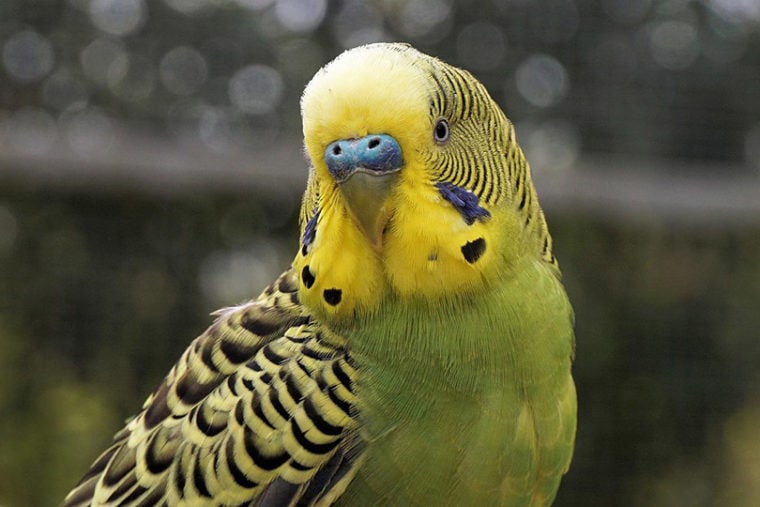
The Budgerigar, or Budgie for short, is the third most popular pet in the world, right behind dogs and cats. If you’ve ever held one of these adorable birds, then you know exactly why. Not only are they beautiful avian specimens with bright and vibrant colorations, they’re also loving and affectionate pets that make excellent companions.
If you’ve looked at Budgies before (also called Parakeets in parts of the world), you’ve likely seen several color variations and patterns on birds that look pretty different from each other. They’re all Budgies, but just how many are there? The answer might surprise you! Let’s take a closer look at this iconic bird and the different types of them that are available.
The Two Main Types of Budgerigar
Though you’ve likely seen many color variations of Budgerigars, there are only two different types of this bird: the traditional Budgerigar and the English Budgie.
The traditional Budgerigar hails from Australia and is the only naturally occurring Budgie. They all have the same coloration: green and yellow with black stripes and flight and tail feathers that are a mix of blue, green, and black.
The English Budgie is not a naturally occurring bird. Instead, it was created through breeding programs for the pet trade market, which is where we get such a variety of amazing Budgie colorations!
Color Variations of the English Budgie
All Budgies with non-traditional coloration were bred in captivity. Through this breeding, as many as 32 color mutations have been created. It’s important to note that these are not different breeds or species, just different color mutations.
Color variations of the English Budgie can be broken down into two main subgroups — white-based and yellow-based. Each of them can have zero, one, or two dark factors that will further enhance their colorations. Let’s take a closer look at several of the most common color combinations of this beautiful bird.
White-Based Budgie Variations
1. Sky Blue Budgie

With no dark factors present, sky blue is the lightest blue color variation for Budgies. Technically, it’s a green bird minus the yellow, which leaves just the light, sky blue coloration. They also have bright purple patches on their cheeks with dark blue tail feathers.
2. Cobalt Budgie

This is blue with a single dark factor. Cobalt is a much darker shade of blue than sky blue. These birds still have bright purple cheeks and dark blue tails.
3. Mauve Budgie

With two dark factors, Mauve is the darkest color blue for Budgies. It can look almost grey with a blueish tint to it. The easiest way to tell a Mauve apart from a Gray is the cheeks. The Mauve Budgies will still have bright purple cheeks and dark blue tails like the other blue variations.
4. Gray Budgie

The gray variation of Budgie has lost all of its blue tint and is instead gray on most of its body. However, their faces still have cheek patches, though they’re now blue, gray, or a blueish-gray, and the tail feathers have become black. Grays come in light, medium, and dark shades, similar to blues.
5. Violet Budgie

The violet coloration is a darkening gene that will enrich a Budgie’s main body color. You can get blue and green Budgies with the violet gene, but it’s most attractive with the blue Budgies. Sometimes, it can develop into very deep shades of violet coloration, known as visual violet.
6. White Budgie

As the name implies, white Budgies are all white. They can sometimes have accent colors in small amounts, but pure white budgies are also common with no additional colorations.
7. Albino Budgie

Albino Budgies lack all pigment, making them a stark white color all over. Interestingly, they can still have dark factors that just don’t display visually.
Yellow-Based Budgie Variations
8. Light Green Budgie

This is the traditional, natural color pattern for a Budgie. It has no dark factors, which is why it’s so bright. But underneath, deep in their genes, are blue and yellow factors that combine to create green. That’s why selective breeding has been able to produce so many variations.
9. Dark Green Budgie

This is green with a single dark factor, making a much deeper and less bright shade of green. Cheek patches on dark green Budgies are still violet with dark blue tail feathers.
10. Olive Budgie

This is the darkest shade of green you can get on a Budgie, created when two dark factors are present. While most green Budgies are a single, smooth shade of green, olive-colored Budgies tend to be more splotchy. Olive Budgies have purple patches on their cheeks and dark blue tail feathers.
11. Gray-Green Budgie

This color variation is very similar to olive. The main difference is the color of their cheeks and tails. Gray-green Budgies have gray/blue cheeks with black tail feathers.
12. Yellow Budgie

Yellow budgies have a very unique look. They can either be completely yellow with no other colors or they can be mostly yellow with bright green patches on their undersides.
13. Lutino Budgie

This is the yellow-based color variation of albino. With a lutino Budgie, the color will be more yellow, with white/silver cheek patches.
Conclusion
As you can tell, there are a surprising number of Budgie variations available. Though the traditional Budgerigar is just green and yellow, all of these incredible color variations have been created through selective breeding. With so many options available, you can certainly find a Budgie that will perfectly fit your personality. After all, they make excellent pets and can even learn to talk and keep you company!
Related Reads:
- How to Choose the Right Cage Size for Budgies
- How Long Do Budgies Live? Average Lifespan, Data & Care
Featured Image Credit: webandi, Pixabay









